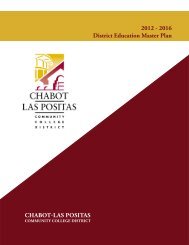City College of San Francisco - California Competes
City College of San Francisco - California Competes
City College of San Francisco - California Competes
You also want an ePaper? Increase the reach of your titles
YUMPU automatically turns print PDFs into web optimized ePapers that Google loves.
THEME IV<br />
The <strong>College</strong> contacted the National Association <strong>of</strong> Student Financial Aid Administrators (NASFAA) for<br />
guidance in addressing the Financial Aid challenge in a systematic fashion. In 1999, NASFAA pulled<br />
together a team <strong>of</strong> financial aid pr<strong>of</strong>essionals from various colleges who spent a couple <strong>of</strong> weeks at CCSF,<br />
doing a complete review <strong>of</strong> all aspects <strong>of</strong> the operation; essentially a performance audit. In 2000, goals<br />
were identified in the Student Development Education Plan, effectively serving to operationalize<br />
the decision to revamp Financial Aid services.<br />
In 2000, when the current Dean <strong>of</strong> Financial Aid, Jorge Bell, came into his position, the improvement<br />
process further accelerated. At that time, the backlog <strong>of</strong> financial aid paperwork was still considered to be<br />
at unacceptable levels, with students having to wait practically all semester before their aid came through.<br />
In July <strong>of</strong> 2001, administrators and staff came in evenings and weekends to get rid <strong>of</strong> the backlog <strong>of</strong> some<br />
3,000 student applications, ensuring students would have their aid in place by the beginning <strong>of</strong> the semester.<br />
The Dean <strong>of</strong> Financial Aid is emphatic in his characterization <strong>of</strong> that period: “We resolved never to go<br />
through that again!”<br />
In 2002, during the drafting <strong>of</strong> the Strategic Plan 2003-2008, expanding and promoting Financial Aid was<br />
highlighted as the first plan under Strategic Objective 5. In the implementation <strong>of</strong> that Plan, references<br />
to improving Financial Aid were transferred into several subsequent <strong>College</strong> Annual Plans. (Financial Aid<br />
goes through an annual financial audit and a periodic CAL Grant audit, but these, although stringent,<br />
are compliance-based rather than focused specifically on improving service.)<br />
Implementation. Part <strong>of</strong> the strategy for turning that situation around in a lasting way was training.<br />
Staff development activities began to take place as <strong>of</strong>ten as every week. The Office continued to seek<br />
available outside advice. Reports the Dean, “The experts from Region 9 <strong>of</strong> the U.S. Department <strong>of</strong><br />
Education spent a whole day with us.” The Dean also coached a number <strong>of</strong> managers himself on an<br />
ongoing basis. In addition, a branch <strong>of</strong> the <strong>California</strong> Student Aid Commission, the Ed Fund, has provided<br />
staff with free customer service training. In 2001, a group <strong>of</strong> consultants was hired and a two-day staff<br />
development retreat was held. Among other improvements, it was suggested that staff form internal<br />
workgroups for addressing problems, such as the need that staff had identified for cross-training. 4 As a<br />
means <strong>of</strong> implementing ongoing improvements, the Office later developed its own evaluation tool, which<br />
it uses to assess the level <strong>of</strong> student satisfaction, determine work flow issues, and redeploy personnel<br />
within the Office. With the aid <strong>of</strong> technology, processes were streamlined, so that instead <strong>of</strong> being<br />
batched, data was entered with the student present at the counter. Also very importantly, the Financial<br />
Aid Appeals Process is no longer carried out by staff, but by counselors who can advise students on ways<br />
to stay in school without aid if need be, and who can set up an education plan with them.<br />
Funding. Financial Aid, through the Student Development Division, received increased funding during<br />
the years in question. From 2000 to the present, a high priority has been given to the improvement<br />
<strong>of</strong> student services as a whole, and Financial Aid has been further emphasized as a high-impact service.<br />
In addition, as <strong>California</strong> community college student fees have continued to rise, the state has diverted<br />
former Partnership for Excellence funds into funding for increased financial aid outreach. The Office<br />
began to work very closely with other departments in the Student Development Division, such as<br />
Extended Opportunity Programs and Services (EOPS), Outreach and Recruitment, and the retention<br />
programs. It also worked more closely with Public Information and Marketing. In 2004, state funding<br />
for financial aid outreach financed bilingual marketing efforts to inform students <strong>of</strong> available financial<br />
aid and included 1,200 cable and ethnic TV spots and the mailing <strong>of</strong> 380,000 postcards featuring<br />
outstanding graduates <strong>of</strong> the <strong>College</strong>. Budgeting has been responsive to the Financial Aid case. Where<br />
4 Other internal staff workgroups addressed flow processing, absenteeism, internal evaluation.<br />
CITY COLLEGE OF SAN FRANCISCO<br />
301







